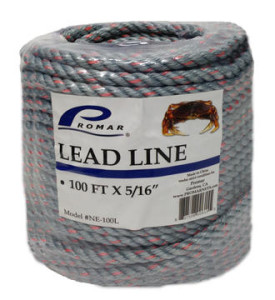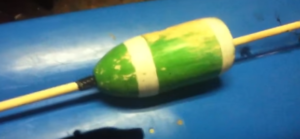How To Set Up A Crab Trap
Setting a crab pot (likewise known as a crab trap) requires a few things. Bated from the obvious crab pot that you lot will demand, you will also demand some sort of rope or zipper in which you lot volition haul up your catch and use to prepare your crab pot. Allow's show you the ropes.
Rope Type:
The rope used to attach your crab pot to must be sturdy enough to hold the contents of the crab pot and the crab pot itself. Depending on your crab pot size and weight, different ropes are suitable for your specific needs. While serious, commercial crabbers will utilize crab pots that weight upward to 1000 pounds, recreational crabbers similar you will probably just have two-3 crab pots at ten-20 pounds each.  So you probably won't need a super tough steel wire just yous want something sufficient. As far every bit tensile forcefulness goes (how much poundage/force your rope is gauged for), anything around 50-60 pounds is more than enough just to be safe and based on your price range, you may want something rated for 100 pounds. If the ropes you are checking out don't have the rating or are looking for a cheap alternative, poly rope
So you probably won't need a super tough steel wire just yous want something sufficient. As far every bit tensile forcefulness goes (how much poundage/force your rope is gauged for), anything around 50-60 pounds is more than enough just to be safe and based on your price range, you may want something rated for 100 pounds. If the ropes you are checking out don't have the rating or are looking for a cheap alternative, poly rope with a diameter of ¼-½ inches should be good. This blazon of rope is normally the cheapest. It'southward tough on your hands and then you might want to wearable some gloves.
More important than the strength of the rope, however, is the length of the rope. The length of the rope MUST exist long enough to reach the bottom of the body of water if you intend to maximize your crab take hold of. Sufficient lengths for the recreational crabber will depend on where you are crabbing but anywhere from 50-100 feet should be good. Usually though, if you lot are crabbing off of a dock or pier, 100 anxiety is more than than enough. If y'all are crabbing from a boat, the depth of the water will probably vary. You lot may want to cheque the max depth earlier you buy your rope. Line telescopic is a term used to ascertain a prophylactic factor for the length of your rope. Y'all desire to add almost 25% extra rope for the depth you are crabbing at. So for instance, if your water depth is 100 feet, your rope length should exist 125 feet as your crab pot may walk while information technology's soaking. 25% line scope is a good dominion of thumb.
When yous are crabbing around boats or from a boat, it is as well of import that your rope SINKS. This is to prevent the rope from snagging onto your boat's propeller or someone else's propeller. This can be a nasty situation that may end upward costing you a lot of fourth dimension and/or money so information technology'southward all-time to avoid information technology. In that location are pretty much 2 means to ensure that your rope sinks. First, you tin tie weights along the length of your rope (perhaps every v-6 anxiety or so). If yous are using poly rope, weights are needed as this blazon of rope floats. Second, y'all can purchase sinkable rope
or leaded rope. As far every bit what is cheaper, it volition probably depend on the length of your rope.
Tying Knots:
Beingness able to tie knots is a good skill to have when crabbing. You volition need to tie the knot to attach the rope to the crab pot, tie the rope to the buoy, or necktie the rope to an anchor piece on a dock or pier. You definitely don't want to lose your crab pot because it's stuck at the bottom of the sea if your rope somehow unties itself with the current or when you are pulling information technology upward. Hither are 3 common knots for crabbing applications:
Non-Slip Mono Knot:
This knot makes a fixed loop at the end and is very strong. It doesn't grip whatever you are tying it to so it allows for more costless movement of the line.
Clove hitch:
A simple all-purpose hitch. Be careful with a clove hitch though as it tin can be undone easy without any load on the line. Use this knot in combination with another one to preclude it from unraveling.
Bowline knot:
This makes a reasonably secure loop at the end of your rope. It is very versatile and easy to make.
There's nothing that says you can't apply knots in combinations to be safer. Channel your inner boy/daughter lookout man and knot away!
Buoys:
 Now that you lot have gotten the hang of the ropes, literally, let'southward talk about buoys. If you are using crab pots, buoys are important to bespeak where you have set your pots and information technology tells others who the pot belongs to. In most cases and if your crab pots are left unattended, buoys are required by constabulary and must exist labeled appropriately. Generally, you demand to label the buoys with your proper name and accost. Information technology would be wise to paint your buoys a distinct color and so that y'all tin can easily spot them. Information technology's non required but is proficient practice. You can attach your rope to the beacon using any of the previous knots mentioned. Of course though, buoys are only needed if you plan on crabbing in the open up water with a boat. If yous are crabbing on a dock or pier, y'all may fix your pot to an zipper point. Nevertheless, it may all the same be wise to label your line.
Now that you lot have gotten the hang of the ropes, literally, let'southward talk about buoys. If you are using crab pots, buoys are important to bespeak where you have set your pots and information technology tells others who the pot belongs to. In most cases and if your crab pots are left unattended, buoys are required by constabulary and must exist labeled appropriately. Generally, you demand to label the buoys with your proper name and accost. Information technology would be wise to paint your buoys a distinct color and so that y'all tin can easily spot them. Information technology's non required but is proficient practice. You can attach your rope to the beacon using any of the previous knots mentioned. Of course though, buoys are only needed if you plan on crabbing in the open up water with a boat. If yous are crabbing on a dock or pier, y'all may fix your pot to an zipper point. Nevertheless, it may all the same be wise to label your line.
Bait Box:
Allurement boxes store the allurement inside of yous crab pot and brand information technology more than hard for the crabs to eat all of your allurement. You lot can attach them to your crab pot with zip ties.
Using a Harness to Connect Rope to Crab Pot (Optional):
You may opt to use a harness to connect your rope to the crab pot. Looks similar this:
The advantange of using a harness is that it keeps your crab pot counterbalanced and level as you set it and retireve information technology. Information technology also makes moving the crab pot more stable and egronomic for yous. To connect the harness to the pot, simply snap on the three or four snaps into various parts on the trap. And then apply your favorite knotting technique to tie the rope to the harness. Invest in an inexpensive yet durable harness
and you will thank youself for it later.
Setting your Crab Pots:
Similar to labeling your buoy, you lot may demand to also label your crab pot with your proper name and address. Check with your local area's shell-fishing rules and regulations to see if you need to. Later you take rigged your buoy (if necessary), attached your rope to the crab pot, filled the pot with bait, and labeled your pot, you should advisedly lower it into the h2o until it reaches the bottom. If you desire to exit information technology unattended for a long period of time (a day or more than), it is wise to weight your crab pot with some bricks or something so that information technology doesn't "walk" with the water's current. When pulling your crab pot up from the water, yous can manually do it or if you have a boat, you can use a pulling machinery called a crab pot puller.
Ready to start crabbing? Check out everything you volition need from lead ropes that sink to buoys to quality crab pots at the CrabbingHQ store.
Source: https://crabbinghq.com/howto/rigging-and-setting-crab-pots/

0 Response to "How To Set Up A Crab Trap"
Post a Comment